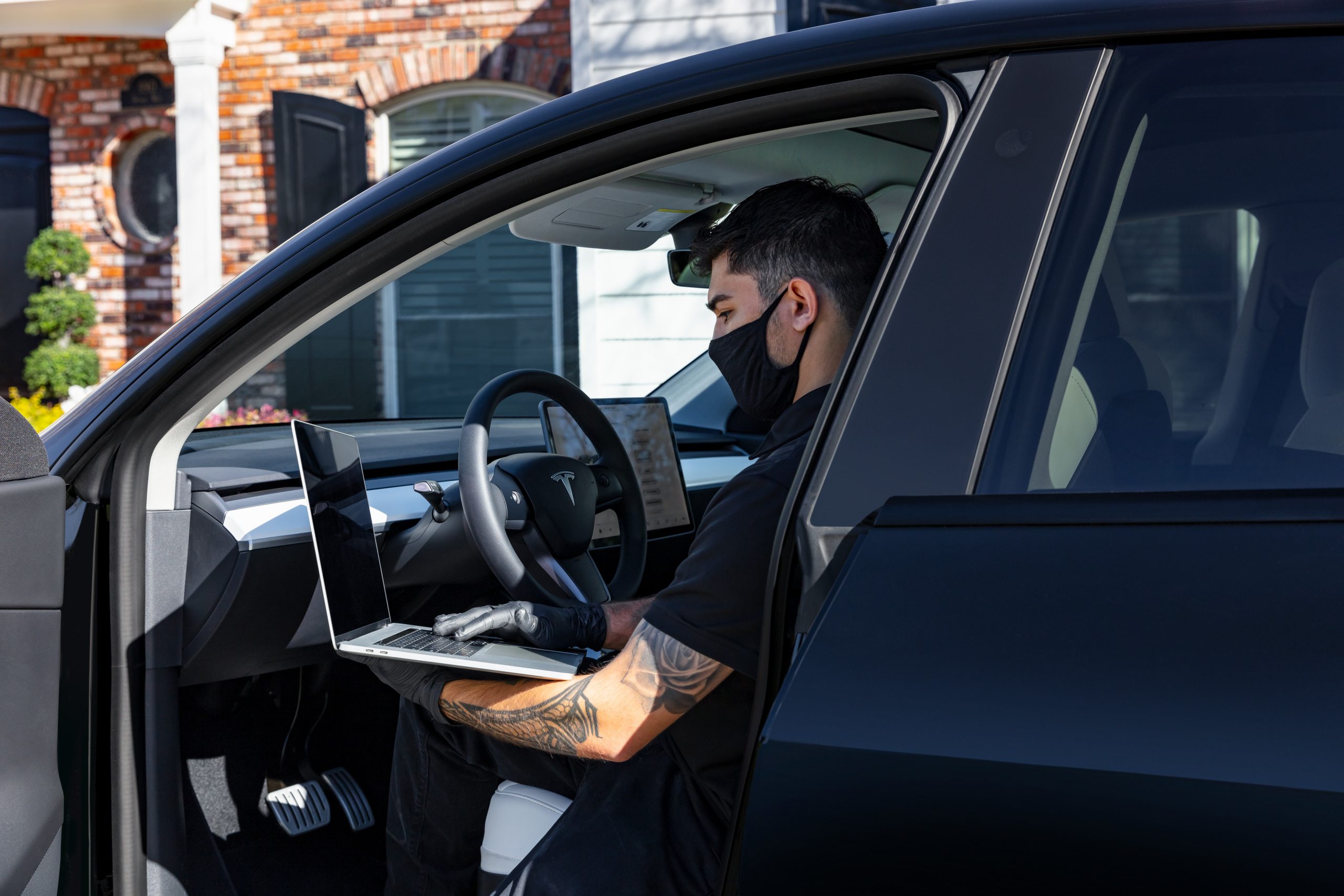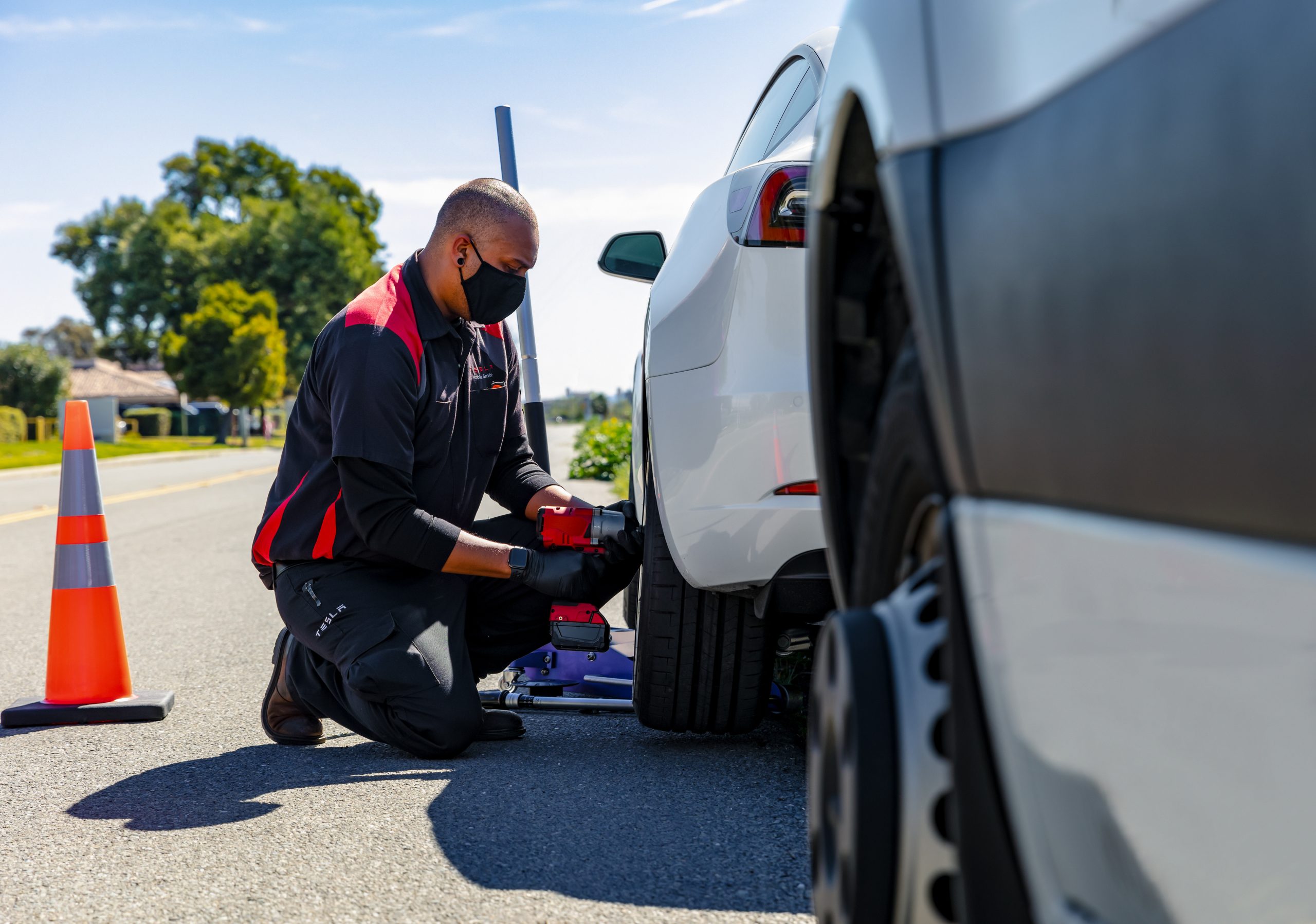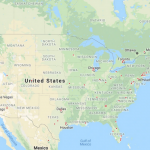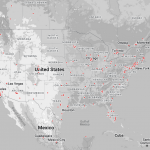Last week, Elon Musk tweeted in a series of updates that Tesla would be attempting to service two-thirds of customer requests “same day.”
One of the many benefits of owning an electric vehicle is the lack of service required. According to Autoblog, of the top 5 most common car repairs – oxygen sensor replacement, inspection of loose fuel cap causing engine light, catalytic converter replacement, mass airflow sensor replacement, and spark plug replacement – none of them are even possible on an electric vehicle. Nonetheless, due to a range of issues, Tesla has had a consistent problem with servicing its ever-growing group of customers’ needs. Musk is set out to change this, and owners should have many reasons to be optimistic!
Working on Tesla North American service.
Goal is 2/3 of cars receive same-day service, no wait.
— Elon Musk (@elonmusk) June 4, 2022
Looking at Tesla’s service problem, it is multifaceted and often self-feeding in nature. To start off, quality control at Tesla has been a known problem, with customers experiencing everything from missing badges to paint issues to panel gaps. All of these issues must be serviced, and much of this service will be done at one of the company’s service centers.
Quality control (QC) service requests, when combined with normal service load, mean that Tesla service centers’ availability is often impaired. Tesla Motors Club forum even has a thread dedicated for service center wait times. This means that customers may be forced to wait longer periods before service, and if the service is not done 100% correctly the first time, the service center doesn’t have the capacity to bring them back immediately.
This lack of availability is compounded by Tesla’s lack of service centers as a whole, some states having only single-digit numbers of service centers available. This means that the service centers that do exist are responsible for a larger number of vehicles. And while independent service centers exist commonly throughout the US, many refuse to work on Tesla products or any electric vehicles for that matter, even when they have the capability to do the work. Once again, this forces more service requests to Tesla service centers.
Credit: Tesla
Finally, because new car QC requests are often covered by Tesla at no cost, this incentivizes customers to go to service centers for free work instead of going to independent shops that may be able to help them.
These problems have not been ignored by Elon Musk, and since 2018, Tesla has addressed many of these concerns. Most predominantly, since 2018, the number of service centers and the area that they cover has increased drastically. Looking at a map of 2018 and comparing it to now, areas such as New England, the Pacific Northwest, and the South have all seen massive increases in capacity. Tesla aimed to open one new Service Center per week in 2021, and, in general, the automaker has experimented with many different specialized service programs.
- Map of Tesla service centers in the US as of 2018.
- Map of Tesla service centers in the US in 2022
This is combined with an increase in capacity in Tesla’s mobile repair teams, who can often address service requests before the customer has to come to a service center. And in more recent news, Tesla has even made their repair manual free for customers to access, allowing more repairs to be done outside of service centers.
Another obvious change consumers have seen is an improvement in QC. Even according to JD Power’s rankings of brands by initial quality, from 2020 to 2021, Tesla has reduced the number of “problems per 100 vehicles” from 250 in 2020 to 231 in 2021, a number that is competitive with brands like Audi (240) and VW (213).
Service centers themselves have also been changed over the past 4 years with the inclusion of F1 style pit lanes that allow customers to be more quickly addressed and hence allow the service team to address more requests in a day.
Nonetheless, many have been concerned that these changes have not been enough to fix the Tesla service issue. Leading many to think about what could be done to improve the situation. A couple of options have been put forward by industry professionals and Twitter users alike. One such suggestion has been the expansion of the Tesla START program, a program that teaches individuals how to work on Teslas and then places them with a full-time job at a Service Center location across the country. Currently, the program is offered at eight colleges across the country: Rio Honda Community College in Los Angeles, Central Piedmont Community College in Charlotte, North Carolina, Shoreline Community College in Seattle, Evergreen Valley College in San Jose, California, Suffolk Community College in Selden, New York, Miami Dade College in Florida, Texas State Technical College in Waco, Texas, and Sinclair Community College in Dayton, Ohio.
Overall, the changes made in the past 4 years should give Tesla’s current and future customers much to be optimistic about. QC has improved, the speed of service operation has increased, service manuals are free and open to anyone, and the number of service centers has increased. The only question is, what is Elon Musk planning on implementing next to improve Tesla’s Service department?
What do you think of the article? Do you have any comments, questions, or concerns? Shoot me an email at william@teslarati.com. You can also reach me on Twitter @WilliamWritin. If you have news tips, email us at tips@teslarati.com
News
Tesla launches in India with Model Y, showing pricing will be biggest challenge
Tesla finally got its Model Y launched in India, but it will surely come at a price for consumers.

Tesla has officially launched in India following years of delays, as it brought its Model Y to the market for the first time on Tuesday.
However, the launch showed that pricing is going to be its biggest challenge. The all-electric Model Y is priced significantly higher than in other major markets in which Tesla operates.
On Tuesday, Tesla’s Model Y went up for sale for 59,89,000 rupees for the Rear-Wheel Drive configuration, while the Long Range Rear-Wheel Drive was priced at 67,89,000.
This equates to $69,686 for the RWD and $78,994 for the Long Range RWD, a substantial markup compared to what these cars sell for in the United States.
🚨 Here’s the difference in price for the Tesla Model Y in the U.S. compared to India.
🚨 59,89,000 is $69,686
🚨 67,89,000 is $78,994 pic.twitter.com/7EUzyWLcED— TESLARATI (@Teslarati) July 15, 2025
Deliveries are currently scheduled for the third quarter, and it will be interesting to see how many units they can sell in the market at this price point.
The price includes tariffs and additional fees that are applied by the Indian government, which has aimed to work with foreign automakers to come to terms on lower duties that increase vehicle cost.
Tesla Model Y seen testing under wraps in India ahead of launch
There is a chance that these duties will be removed, which would create a more stable and affordable pricing model for Tesla in the future. President Trump and Indian Prime Minister Narendra Modi continue to iron out those details.
Maharashtra Chief Minister Devendra Fadnavis said to reporters outside the company’s new outlet in the region (via Reuters):
“In the future, we wish to see R&D and manufacturing done in India, and I am sure at an appropriate stage, Tesla will think about it.”
It appears to be eerily similar to the same “game of chicken” Tesla played with Indian government officials for the past few years. Tesla has always wanted to enter India, but was unable to do so due to these import duties.
India wanted Tesla to commit to building a Gigafactory in the country, but Tesla wanted to test demand first.
It seems this could be that demand test, and the duties are going to have a significant impact on what demand will actually be.
Elon Musk
Tesla ups Robotaxi fare price to another comical figure with service area expansion
Tesla upped its fare price for a Robotaxi ride from $4.20 to, you guessed it, $6.90.

Tesla has upped its fare price for the Robotaxi platform in Austin for the first time since its launch on June 22. The increase came on the same day that Tesla expanded its Service Area for the Robotaxi ride-hailing service, offering rides to a broader portion of the city.
The price is up from $4.20, a figure that many Tesla fans will find amusing, considering CEO Elon Musk has used that number, as well as ’69,’ as a light-hearted attempt at comedy over the past several years.
Musk confirmed yesterday that Tesla would up the price per ride from that $4.20 point to $6.90. Are we really surprised that is what the company decided on, as the expansion of the Service Area also took effect on Monday?
But the price is now a princely $6.90, as foretold in the prophecy 😂
— Elon Musk (@elonmusk) July 14, 2025
The Service Area expansion was also somewhat of a joke too, especially considering the shape of the new region where the driverless service can travel.
I wrote yesterday about how it might be funny, but in reality, it is more of a message to competitors that Tesla can expand in Austin wherever it wants at any time.
Tesla’s Robotaxi expansion wasn’t a joke, it was a warning to competitors
It was only a matter of time before the Robotaxi platform would subject riders to a higher, flat fee for a ride. This is primarily due to two reasons: the size of the access program is increasing, and, more importantly, the service area is expanding in size.
Tesla has already surpassed Waymo in Austin in terms of its service area, which is roughly five square miles larger. Waymo launched driverless rides to the public back in March, while Tesla’s just became available to a small group in June. Tesla has already expanded it, allowing new members to hail a ride from a driverless Model Y nearly every day.
The Robotaxi app is also becoming more robust as Tesla is adding new features with updates. It has already been updated on two occasions, with the most recent improvements being rolled out yesterday.
Tesla updates Robotaxi app with several big changes, including wider service area
News
Tesla Model Y and Model 3 dominate U.S. EV sales despite headwinds
Tesla’s two mainstream vehicles accounted for more than 40% of all EVs sold in the United States in Q2 2025.

Tesla’s Model Y and Model 3 remained the top-selling electric vehicles in the U.S. during Q2 2025, even as the broader EV market dipped 6.3% year-over-year.
The Model Y logged 86,120 units sold, followed by the Model 3 at 48,803. This means that Tesla’s two mainstream vehicles accounted for 43% of all EVs sold in the United States during the second quarter, as per data from Cox Automotive.
Tesla leads amid tax credit uncertainty and a tough first half
Tesla’s performance in Q2 is notable given a series of hurdles earlier in the year. The company temporarily paused Model Y deliveries in Q1 as it transitioned to the production of the new Model Y, and its retail presence was hit by protests and vandalism tied to political backlash against CEO Elon Musk. The fallout carried into Q2, yet Tesla’s two mass-market vehicles still outsold the next eight EVs combined.
Q2 marked just the third-ever YoY decline in quarterly EV sales, totaling 310,839 units. Electric vehicle sales, however, were still up 4.9% from Q1 and reached a record 607,089 units in the first half of 2025. Analysts also expect a surge in Q3 as buyers rush to qualify for federal EV tax credits before they expire on October 1, Cox Automotive noted in a post.
Legacy rivals gain ground, but Tesla holds its commanding lead
General Motors more than doubled its EV volume in the first half of 2025, selling over 78,000 units and boosting its EV market share to 12.9%. Chevrolet became the second-best-selling EV brand, pushing GM past Ford and Hyundai. Tesla, however, still retained a commanding 44.7% electric vehicle market share despite a 12% drop in in Q2 revenue, following a decline of almost 9% in Q1.
Incentives reached record highs in Q2, averaging 14.8% of transaction prices, roughly $8,500 per vehicle. As government support winds down, the used EV market is also gaining momentum, with over 100,000 used EVs sold in Q2.
Q2 2025 Kelley Blue Book EV Sales Report by Simon Alvarez on Scribd
-

 News3 days ago
News3 days agoTesla debuts hands-free Grok AI with update 2025.26: What you need to know
-

 Elon Musk1 week ago
Elon Musk1 week agoElon Musk confirms Grok 4 launch on July 9 with livestream event
-

 Elon Musk5 days ago
Elon Musk5 days agoxAI launches Grok 4 with new $300/month SuperGrok Heavy subscription
-

 News2 weeks ago
News2 weeks agoTesla Model 3 ranks as the safest new car in Europe for 2025, per Euro NCAP tests
-

 Elon Musk2 weeks ago
Elon Musk2 weeks agoxAI’s Memphis data center receives air permit despite community criticism
-

 News5 days ago
News5 days agoTesla begins Robotaxi certification push in Arizona: report
-

 Elon Musk2 weeks ago
Elon Musk2 weeks agoTesla reveals it is using AI to make factories more sustainable: here’s how
-

 Elon Musk2 weeks ago
Elon Musk2 weeks agoTesla scrambles after Musk sidekick exit, CEO takes over sales
















